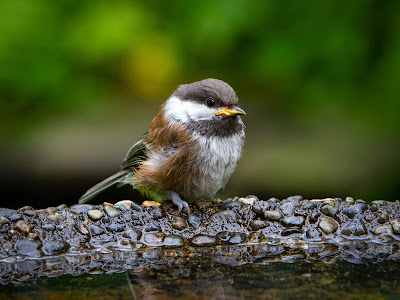For the Birds: Baby Birds are still a Happen’ Thing
Friday, July 1, 2022
 |
| American Robin. by Elaine Chuang -- notice the gape (colored area at base of bill) newly fledged - still begging for food |
Three Dark-eyed Juncos just hatched in my hanging fuchsia plant just a week ago. Oh, Happy Day!
Many local birds have second broods. This year because of the cool wet spring which made bugs and caterpillars scarce, many of our birds are trying again if their first brood didn’t make it, or not all the nestlings survived.
 |
| Chestnut-backed Chickadee by Craig Kerns gape still showing--first bath? |
So do our local birds like juncos, Song Sparrows, Spotted Towhees, and Red-breasted Nuthatches.
Our native woodpeckers, and raptors do not.
When birds leave their nest, they are the full size of their parents, unlike ducks and waterfowl.
When birds leave their nest, they are the full size of their parents, unlike ducks and waterfowl.
Indeed, most fledglings appear a little larger because their fresh feathers are fluffy, whereas their harried, overworked parents are somewhat bedraggled.
Now is the time to be watching for nests in tall weeds, young birds with extra color at the base of their beaks, and fledglings that have awkward flying, especially after taking their first couple of baths.
Now is the time to be watching for nests in tall weeds, young birds with extra color at the base of their beaks, and fledglings that have awkward flying, especially after taking their first couple of baths.
 |
| Dark-eyed Junco feeding fledgling photo by Christine Southwick |
That only happens for the first few days. Then the parents start teaching their young how to feed themselves, often bringing their young to feeders, and suet.
Northern Flickers, Downy, and Hairy and Pileated Woodpeckers will bring their offspring to my suet feeders.
Northern Flickers, Downy, and Hairy and Pileated Woodpeckers will bring their offspring to my suet feeders.
The parents start out hanging on the suet, getting a bill-full and flying over to the waiting youngsters, sticking the suet into their mouths.
This is repeated until the parent thinks that they have had enough instruction, where upon they wait for the youngsters to come get their own suet. As with most youngsters, some “get it” sooner than others.
 |
| What are these birds? Juvenile junco on left, juvie Spotted Towhee on right Photo by Christine Southwick |
- Loss of Habitat; Keep tall trees, plant native shrubs, trees and flowers-native plants support the bus that our birds need.
- Death by cats; Keep your cats inside, or build/buy them an indoor-outdoor run. Ground nesters, like Juncos, Towhees and Song Sparrows nest in tall grass, bases of ferns, or weeds until early August.
- Window collisions and other objects; Position your feeders either within three feet of your windows, or more than ten feet away. If you have a window that gets hit, put up window cling-designs, visual distractors, anything to break up the reflection of an inviting habitat.




0 comments:
Post a Comment